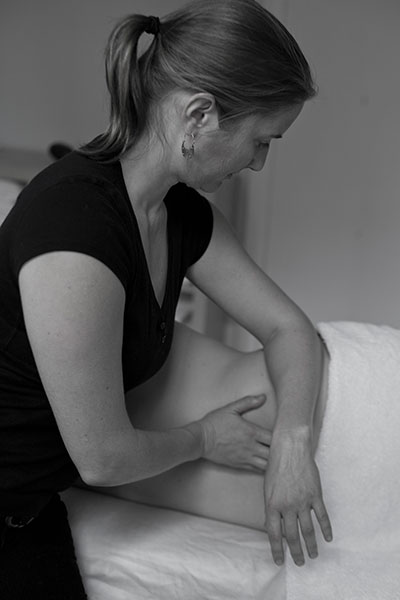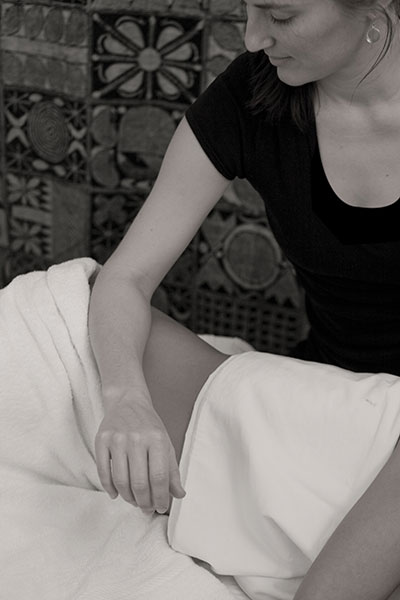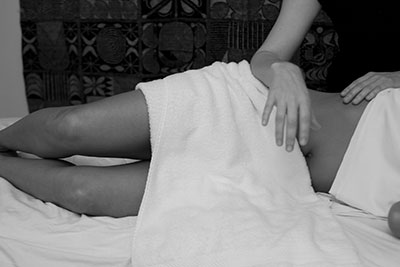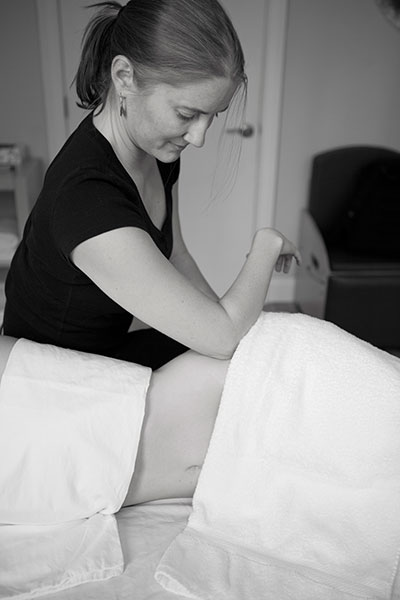
Features
Management
Operations
Putting pain aside
When I learned how to massage a client in side-lying position in massage school, it was considered a default position to be used on those who couldn’t lie prone, such as pregnant women.
January 3, 2014 By Shari Auth
When I learned how to massage a client in side-lying position in massage school, it was considered a default position to be used on those who couldn’t lie prone, such as pregnant women. Side-lying position was like the alternate cheerleader who only performed when the prettier girl was out sick.
In practice, I’ve learned just the opposite: that side-lying position is the secret weapon for clients with hip and shoulder pain.
When a client comes in with a pain in their shoulders or hips, I almost invariably start the session with the client positioned on their side. Side-lying position is the most useful way for me to access, troubleshoot and treat their pain. In side-lying position the shoulders and hips have freedom to move. This potential freedom of movement is an invaluable tool in determining where my client is tight, as well as offering me more possibilities to stretch, lengthen and massage their tight joints and muscles.
Furthermore, as many practitioners don’t use side-lying position to treat pain, it will give you an advantage. I have helped many people in pain who came to me after seeing a number of other therapists. Because I use side-lying position, I can better access and relieve the tightness that is causing them pain. They leave thinking I’m a miracle worker – but really, I’m just using the advantages that side-lying position offers. Here are some of them.
Diagnosis
Side-lying position is great for diagnosing muscle tightness in your client. Because the shoulders and hips have freedom to move in side-lying position, the therapist can move a client’s shoulders or pelvis forward, back, up and down to feel for where the joint is impinged. The therapist can also look at their client’s hips and shoulder joints and see if the joint is tilted anterior, posterior or superior. This visual and tactile information can help the therapist diagnose, treat and structure the treatment session.
Troubleshooting
Because the whole shoulder girdle and pelvic girdle are available to be massaged in side-lying position, troubleshooting pain is easier. Doing massage is like peeling an onion. As one layer or muscle releases, the practitioner moves on to massage the next layer or other muscles that are tight. Side-lying position allows you to move easily from the front body to the back body and/or side body: there is no need to have your client flip over because the whole shoulder or hip is available.
Balancing and realigning the joint
Because the front, back and sides of the shoulder and pelvic joints are available to be massaged in side-lying position, it’s possible to balance the front of the joint respective to the back of the joint and vice versa.
Example: Shoulders have a tendency to round forward; in side-lying position it’s possible to massage the front of the shoulder (with a stretch if necessary), releasing the tension in the chest that may be pulling the shoulder forward, as well as massaging the tension that builds in the back of the shoulders from this kind of misalignment.
Stretching and lengthening
Freedom of movement in a joint means more opportunities to stretch. Take the shoulders, for example: in side-lying position it’s possible to stretch while massaging both the chest muscles and the rhomboids without changing position. Tight hips and shoulders tend to move up the body. Oftentimes, mothers favour one hip to carry their baby on, causing a misalignment in their pelvis (the hip that carries the baby ends up being higher than the other one). It’s hard to stretch and lengthen the quadratus lumborum (QL) in prone position; in side-lying position the therapist can traction a downward stretch while massaging the QL, creating length in the QL and encouraging the hip to move back down.
Body mechanics
Body mechanics experts are in favour of side-lying position because it allows the practitioner to maintain a neutral spine while massaging. Because the client’s body is higher up on the table, the practitioner is able to sit up straighter. In addition, when massaging in side-lying position there are many opportunities to sit on the table. Because the client takes up much less space on the table, there is plenty of room for you. Massage is a laborious profession; it’s important for career longevity to take advantage of opportunities to sit down.
Client comfort
Some massage practitioners are in the habit of massaging their clients only in prone and supine positions, and think they are being bothersome to ask a client to turn on their sides. Nothing could be farther from the truth. Side-lying position is reminiscent of a fetal position and is the position many people commonly sleep in. It is very comfortable for clients. Many clients prefer it to being face down in the face cradle. Once you’ve massaged your clients in side-lying position, don’t be surprised if they request it the next time.
Clinical advantage
Because many massage practitioners are in the habit of massaging their clients only in prone and supine positions, they are limited to the benefits these positions provide and are not always able to help their clients. Learning to massage in side-lying position, in addition to prone and supine positions, will give you an edge above the competition, because you will be able to treat a wider variety of issues more effectively.
Forearm massage
It’s possible to massage the whole body in side-lying position using the forearms. Because the forearms are more durable than the hands, fingers or thumbs, you’ll be able to work longer and deeper on your clients with less wear and tear on the more fragile joints of the hands.
Better access to the lateral sides of the body
One of the more obvious advantages to positioning your client on their side is having access to the muscles that run along the sides of the body, such as the Tensor Fasciae Latae (TFL). In side-lying position it is possible to use downward pressure to massage the TFL. The TFL is a small muscle that, when tight, can cause enormous pain. I have often had new clients come in complaining of stubborn hip pain, and tell me about the bodywork they’ve had on it with no relief. Once I release the TFL, the pain is gone and they think I’m a miracle worker. It’s hard to access the TFL from supine or prone position, but from side-lying position it’s easy.
Technique
To massage the TFL in side-lying position using your forearm, instruct your client to lie on their side, and prop their head with a pillow or the face cradle cushion. Make sure the height of the head support allows their neck to be parallel with the floor. Have your client keep their legs together with both their knees bent (a towel between the knees and ankles is optional).
 |
|
| Image 1: Place upper forearm just below the iliac crest. | |
 |
|
| Image 2: Place your upper forearm closest to client’s hips just below the iliac crest and rest other forearm on client’s rib cage. | |
 |
|
| Image 3: Ask client to slowly lift top knee about an inch. | |
 |
|
| Image 4: Massaging between the anterior iliac spine and the greater trochanter. |
Massaging the TFL can be done from either a standing or a seated position. If your client has wide hips, you may need to stand. Sit behind your client’s lower back and place your upper forearm just below the iliac crest (Image 1). Be sure to use the upper forearm, because it provides more leverage than the middle or lower forearm. This may include the olecranon process but the touch isn’t pokey: it’s broad because it includes the forearm and a large surface area of contact. If your shoulder is above your elbow and your upper arm is near perpendicular with the floor, performing this stroke from a seated position will work for you.
If not, stand up behind your client’s lower back, spread your legs so you are standing with your feet wider than your hips, bend your knees slightly, keep your back straight and chest open. Place your upper forearm closest to your client’s hips just below their iliac crest and rest the other forearm comfortably on their rib cage (Image 2).
Glide down the hip abductors from the iliac crest to the greater trochanter, tracing the side seam of the body. When you reach the greater trochanter, lift up and begin the stroke again.
To intensify this stroke, ask your client to slowly lift their top knee about an inch, keeping their feet together (Image 3). This movement by your client will activate the hip abductors, intensifying the work you’re doing and facilitating a deeper release in the tissue. Be sure to have the client do this movement while you’re gliding your forearm down the hip abductors.
To massage the TFL more specifically, glide to the greater trochanter and then angle your forearm upward (your hand will be higher than your elbow), and continue down the hip, massaging between the anterior iliac spine and the greater trochanter (Image 4). By angling the forearms upward, you are decreasing the area of contact and making it possible to massage this narrow area.
If necessary, have your client slowly lift their top knee again to facilitate further release through this area. This is not a long stroke – you may only go a few inches. Lift up as you reach the end of the TFL and repeat the stroke as necessary.
Side-lying position opens up possibilities by offering another angle to massage your client’s body. If you’re a seasoned practitioner, side-lying position can give you a fresh perspective on the body. If you’re a new practitioner, it will increase your repertoire in a competitive market.
 |
|
Shari Auth is a licensed massage therapist and acupuncturist, certified in the Rolf Method of Structural Integration and Chinese Herbology. She is the founder of the Auth Method and has a DVD, book and home-study course on forearm massage, as well as a new DVD entitled, Auth Method: A Guide To Side-lying Position. For more information visit www.authmethod.com.
Print this page